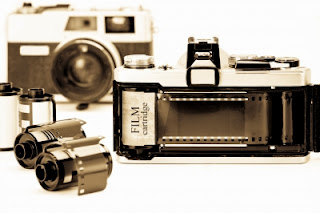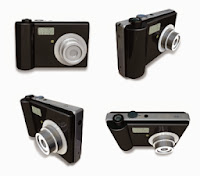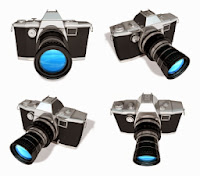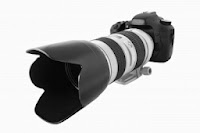The word 'Photography' has been derived from two Greek words 'Photos' and 'Graphein', where Photos means 'Light' and Graphein means 'To write / To draw', which was first coined by a Scientist Sir John F.W. Herschel in the year 1839 for ‘Drawing with Light’ or ‘Light Drawing’. In other words, photography is a technology of capturing images, with a long path of development, by the action of light or other electromagnetic radiation, on a sensitive material, either chemically by means of a photographic film or electronically by means of an image sensor.
In 1822, Joseph Nicéphore Niépce, a French Inventor, had invented a photographic process, which was having exposure time of 8 hours and He named it ‘Heliography’ or ‘Sun Drawing’, which He used to take the World's First Permanent Photograph from Nature with a Camera Obscura and a Pewter Plate coated with Bitumen in the year 1826, that depicts a view from an upstairs window in his estate, Le Gras, in the Burgundy region of France. Later on, Louis-Jacques-Mandé Daguerre, a French Artist and Scenic Painter, had entered into partnership with Joseph Nicéphore Niépce in the year 1829. But, after the death of Joseph Nicéphore Niépce in 1833, Daguerre had continued his experiment with Copper Plates coated with Silver Iodide to produce Direct Positive Images and invented the First Practicable Method of obtaining permanent images with much shorter exposure time in the year 1839 and gave his name to the process as Daguerreotype Process of Photography. In 1841, William Henry Fox Talbot, a British Inventor and Photography Pioneer, had announced his discovery of 'Art of Photogenic Drawing' and named it ‘Calotype’ or ‘Talbotype’ Process, which was based on Prints on a Paper that had been made Light Sensitive, having the concept of a Negative from which many Positive Prints can be made and the use of Gallic Acid for developing the Latent Image, rather than Pewter Plate coated with Bitumen or Copper Plates coated with Silver Iodide.
After that, various advancements were made in the next few years and in 1884, it was George Eastman, an American Innovator and Entrepreneur who founded the Eastman Kodak Company, had developed Roll Film Technology to take over from Photographic Plates and brought a new era in the field of photography.
George Eastman wanted to make photography simple and available to everyone, not only to trained photographers. Since then, Roll Film Technology had spread and became popular all over the World. Even few years ago, we all were using roll films for taking still photos with the help of roll film cameras. But today, we hardly think of buying or using roll film cameras and prefer digital cameras for sheer convenience and ease of use. This is where things have changed and we have already moved into a World of Digital Photography, which has come a long way in a short span of time.
In 1822, Joseph Nicéphore Niépce, a French Inventor, had invented a photographic process, which was having exposure time of 8 hours and He named it ‘Heliography’ or ‘Sun Drawing’, which He used to take the World's First Permanent Photograph from Nature with a Camera Obscura and a Pewter Plate coated with Bitumen in the year 1826, that depicts a view from an upstairs window in his estate, Le Gras, in the Burgundy region of France. Later on, Louis-Jacques-Mandé Daguerre, a French Artist and Scenic Painter, had entered into partnership with Joseph Nicéphore Niépce in the year 1829. But, after the death of Joseph Nicéphore Niépce in 1833, Daguerre had continued his experiment with Copper Plates coated with Silver Iodide to produce Direct Positive Images and invented the First Practicable Method of obtaining permanent images with much shorter exposure time in the year 1839 and gave his name to the process as Daguerreotype Process of Photography. In 1841, William Henry Fox Talbot, a British Inventor and Photography Pioneer, had announced his discovery of 'Art of Photogenic Drawing' and named it ‘Calotype’ or ‘Talbotype’ Process, which was based on Prints on a Paper that had been made Light Sensitive, having the concept of a Negative from which many Positive Prints can be made and the use of Gallic Acid for developing the Latent Image, rather than Pewter Plate coated with Bitumen or Copper Plates coated with Silver Iodide.
 |
35mm Roll Films and Roll Film Cameras(Image courtesy of Toa55 at FreeDigitalPhotos.net) |
George Eastman wanted to make photography simple and available to everyone, not only to trained photographers. Since then, Roll Film Technology had spread and became popular all over the World. Even few years ago, we all were using roll films for taking still photos with the help of roll film cameras. But today, we hardly think of buying or using roll film cameras and prefer digital cameras for sheer convenience and ease of use. This is where things have changed and we have already moved into a World of Digital Photography, which has come a long way in a short span of time.
When we talk about digital photography, it means digital photos or digital images that are composed of small building blocks known as Pixels. The word Pixel has been derived from Picture Element, where Picture = PIX and Element = EL. Every digital image is made up of thousands & millions of pixels that are not visible to our naked eye, but represents the clarity of that image and also determines the Image Resolution.
The Resolution of a digital image is measured in pixel per inch (ppi) i.e. more pixels per inch of a digital image means higher resolution and also determines the maximum print size of that image. The standard resolution for photo quality print is 300ppi, which means 300 pixels per inch. So to determine the print size of a digital image that a Digital Camera is capable to produce, we need to know how many megapixels (million pixels) are there in a Digital Camera.
In today's generation, we can see, almost everyone of us is having a digital camera in our pockets in the form of Mobile Phones, so we all know about megapixels now a days. But the megapixels present in Mobile Phone Cameras are not well capable to produce digital images that are good for quality prints as compared to digital images we get from either Compact Point & Shoot Digital Cameras or from Digital SLR (Single Lens Reflex) Cameras. On the contrary, the digital images that a Mobile Phone Camera is capable to produce can look pretty good on computer monitor rather than in prints, because the standard screen resolution of our computer monitor is only 72ppi for Windows or 96ppi for Macintosh, which is extremely low as compared to print resolution i.e. 300ppi. So, to get the actual quality in a digital image, which will look good both in quality print as well as on our computer monitor, we need to go for either a Compact Point & Shoot Digital Camera or a Digital SLR Camera. But when we talk
about image quality, beside megapixels, we need to understand the concept of Sensor as well, because it
plays a very important role in determining the quality of a digital image. Digital SLR Cameras have much bigger size Sensors as compared to Compact Point & Shoot Digital Cameras, so the digital images that we get from Digital SLR Cameras have much higher image quality and much less noise (noise means dotted grains found in digital images).
As we know that all digital images are made up of pixels and the colours present inside those pixels or in digital image are made by combining three primary colours, i.e. Red, Green & Blue and they are popularly known as RGB colour model or RGB Channels. Each of these three colours have 256 different shades, ranging from 0 to 255, i.e. 256(Red), 256(Green), 256(Blue) and after combining all the three colours we get a total of 16.7 million colours having 8 bits of colour per channel or 24-bit colour (the total of each of the three channels having 8 bits of colour), where bit stands for binary digit.
The Resolution of a digital image is measured in pixel per inch (ppi) i.e. more pixels per inch of a digital image means higher resolution and also determines the maximum print size of that image. The standard resolution for photo quality print is 300ppi, which means 300 pixels per inch. So to determine the print size of a digital image that a Digital Camera is capable to produce, we need to know how many megapixels (million pixels) are there in a Digital Camera.
 |
Point & Shoot Digital Camera
(Image courtesy of Boians Cho Joo Young
at FreeDigitalPhotos.net) |
 |
Old Digital SLR Camera
(Image courtesy of Boians Cho Joo Young
at FreeDigitalPhotos.net) |
 |
Today's Digital SLR Camera
(Image courtesy of Nutdanai
Apikhomboonwaroot at FreeDigitalPhotos.net) |
 |
Today's Digital SLR Camera
(Image courtesy of piyaphantawong
at FreeDigitalPhotos.net) |
As we know that all digital images are made up of pixels and the colours present inside those pixels or in digital image are made by combining three primary colours, i.e. Red, Green & Blue and they are popularly known as RGB colour model or RGB Channels. Each of these three colours have 256 different shades, ranging from 0 to 255, i.e. 256(Red), 256(Green), 256(Blue) and after combining all the three colours we get a total of 16.7 million colours having 8 bits of colour per channel or 24-bit colour (the total of each of the three channels having 8 bits of colour), where bit stands for binary digit.
No comments:
Post a Comment